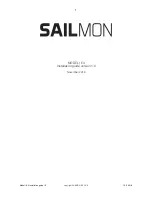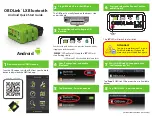
106633-UIM-A-0205
Unitary Products Group
19
IMPORTANT:
The inlet gas pressure operating range table specifies
what the minimum and maximum gas line pressures must be for the fur-
nace to operate safely.
The gas line pressure
MUST BE
•
7” W.C. (1.74 kPA) for Natural Gas
•
11” W.C. (2.74 kPA) for Propane (LP) Gas
in order to obtain the BTU input specified on the rating plate and/or the
nominal manifold pressure specified in these instructions and on the
rating plate.
ADJUSTMENT OF MANIFOLD GAS PRESSURE
Manifold gas pressure may be measured by two different procedures. It
may be measured with the burner box cover in place or it may be mea-
sured with the burner box cover removed. Follow the appropriate sec-
tion in the instructions below. Refer to Figure 23 for a drawing of the
locations of the pressure ports on the gas valve.
Turn gas off at the ball valve or gas cock on gas supply line
before the gas valve. Find the pressure ports on the gas
valve marked OUT P and IN P.
1.
The manifold pressure must be taken at the port marked OUT P.
2.
The inlet gas line pressure must be taken at the port marked IN P.
3.
Using a 3/32” (2.4 mm) Allen wrench, loosen the setscrew by turn-
ing it 1 turn counter clockwise. DO NOT REMOVE THE SET
SCREW FROM THE PRESSURE PORT.
Read the inlet gas pressure using either of the two
methods below.
Reading the gas pressure with the burner box cover in place:
A.
Disconnect the pressure reference hose from the right side of
the burner box. Using a tee fitting and a short piece of hose,
connect the negative side of the manometer to the burner
box as described below.
B.
Remove one end the 5/16” (7.94 mm) ID flexible tubing over
the pressure port on the burner box.
C.
Insert the end of the 5/16” (7.94 mm) tubing, that has the 1/8”
(3.175 mm) adapter at the end of the tube, in to the 1/8”
(3.175 mm) tee.
D.
Connect the 1/8” (3.175 mm) tee to the burner box adapter
and to the negative side of a U-tube manometer or digital
pressure measuring equipment with 2 – 1/8” (3.175 mm)
tubes.
E.
Use the 5/16” (7.94 mm x 1/8” (3.175 mm) reducing coupling
and a 4” (101.6 mm) piece of 1/8” (3.175 mm) tubing to con-
nect the positive side of the manometer to the gas valve pres-
sure reference port. Refer to Figure 24 for connection details.
Reading the gas pressure with the burner box cover removed -
Remove the screws securing the burner box front cover plate. Remove
the cover. The gasket and may stick in place. Connect the positive side
of the manometer to the gas valve as described in E above. There will
be no second connection to the manometer, as it will reference atmo-
spheric pressure. Refer to Figure 24 for connection details.
This gas valve has separate regulator adjustment screws for high fire
and low fire, as shown in Figure 23. The procedure below is used to
adjust either the high fire manifold pressure or the low fire manifold
pressure.
IMPORTANT:
The cap for the pressure regulator must be removed
entirely to gain access to the adjustment screw. Loosening or tightening
the cap does not adjust the flow of gas.
1.
Refer to Figure 23 for location of pressure regulator adjustment
cap and adjustment screws on main gas valve.
2.
Turn gas and electrical supplies on and follow the operating
instructions to place the unit back in operation.
3.
Adjust manifold pressure by adjusting gas valve regulator screw
for the appropriate gas per the following:
IMPORTANT:
If gas valve regulator is turned in (clockwise), manifold
pressure is increased. If screw is turned out (counterclockwise), mani-
fold pressure will decrease.
4.
After the manifold pressure has been adjusted, re-calculate the
furnace input to make sure you have not exceeded the specified
input on the rating plate. Refer to “CALCULATING THE FURNACE
INPUT (NATURAL GAS)”.
5.
Once the correct BTU (kW) input has been established, turn the
gas valve to OFF and turn the electrical supply switch to OFF; then
remove the flexible tubing and fittings from the gas valve pressure
tap and the pressure reference hose from the right side of the
burner box and tighten the pressure tap plug using the 3/32”
(2.4 mm) Allen wrench. Replace the burner box front cover (if it
was removed) and place the pressure reference hose back on the
gas valve.
6.
Turn the electrical and gas supplies back on, and with the burners
in operation, check for gas leakage around the gas valve pressure
port for leakage using an approved gas detector, a non-corrosive
leak detection fluid, or other leak detection methods.
Be sure to relight any gas appliances that were turned off at the
start of this input check.
TABLE 12:
Inlet Gas Pressure Range
INLET GAS PRESSURE RANGE
Natural Gas
Propane (LP)
Minimum
4.5” W.C. (1.12 kPa)
8.0” W.C. (1.99 kPa)
Maximum
10.5” W.C. (2.61 kPa)
13.0” (3.24 kPa) W.C.
TABLE 13:
Nominal Manifold Pressure
NOMINAL MANIFOLD PRESSURE
Natural Gas (High Fire)
3.5" w.c. (0.87 kPa)
Natural Gas (Low Fire)
1.6" w.c. (0.40 kPa)
Propane (LP) Gas (High Fire)
10.0" w.c. (2.488 kPa)
Propane (LP) Gas (Low Fire)
4.0" w.c. (0.99 kPa)
FIGURE 23:
Gas Valve
The manifold pressure must be checked with the screw-off cap for
the gas valve pressure regulator in place. If not, the manifold pres-
sure setting could result in an over-fire condition. A high manifold
pressure will cause an over-fire condition, which could cause pre-
mature heat exchanger failure. If the manifold pressure is too low,
sooting and eventual clogging of the heat exchanger could occur.
Be sure that gas valve regulator cap is in place and burner box to
gas valve pressure reference hose is connected.
INLET
WRENCH
BOSS
INLET
PRESSURE
PORT
ON OFF
SWITCH
LOW STAGE REGULATOR
ADJUSTMENT
OUTLET
OUTLET
PRESSURE
PORT
VENT
PORT
HIGH STAGE REGULATOR
ADJUSTMENT






































